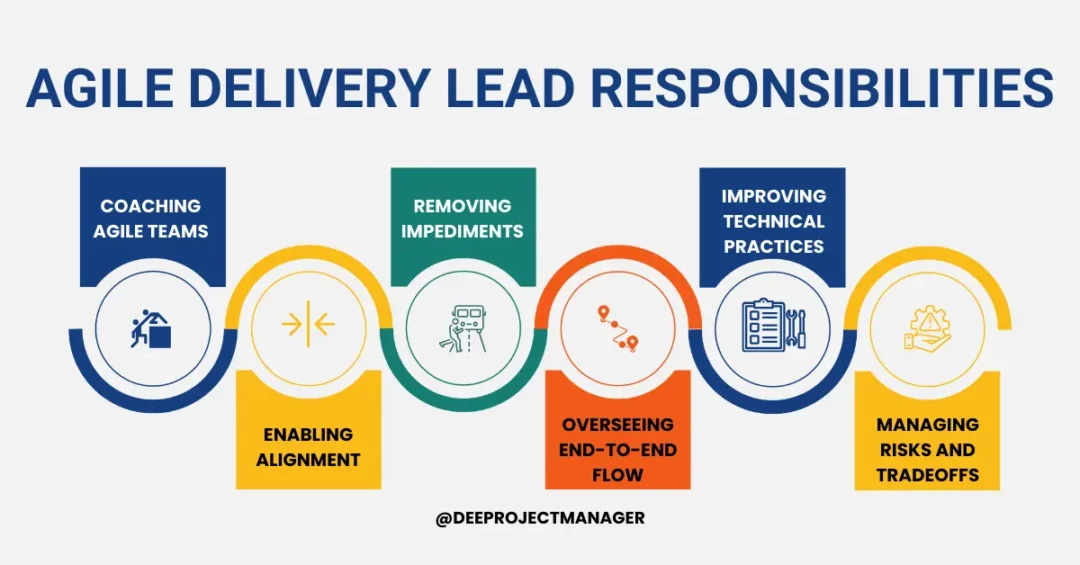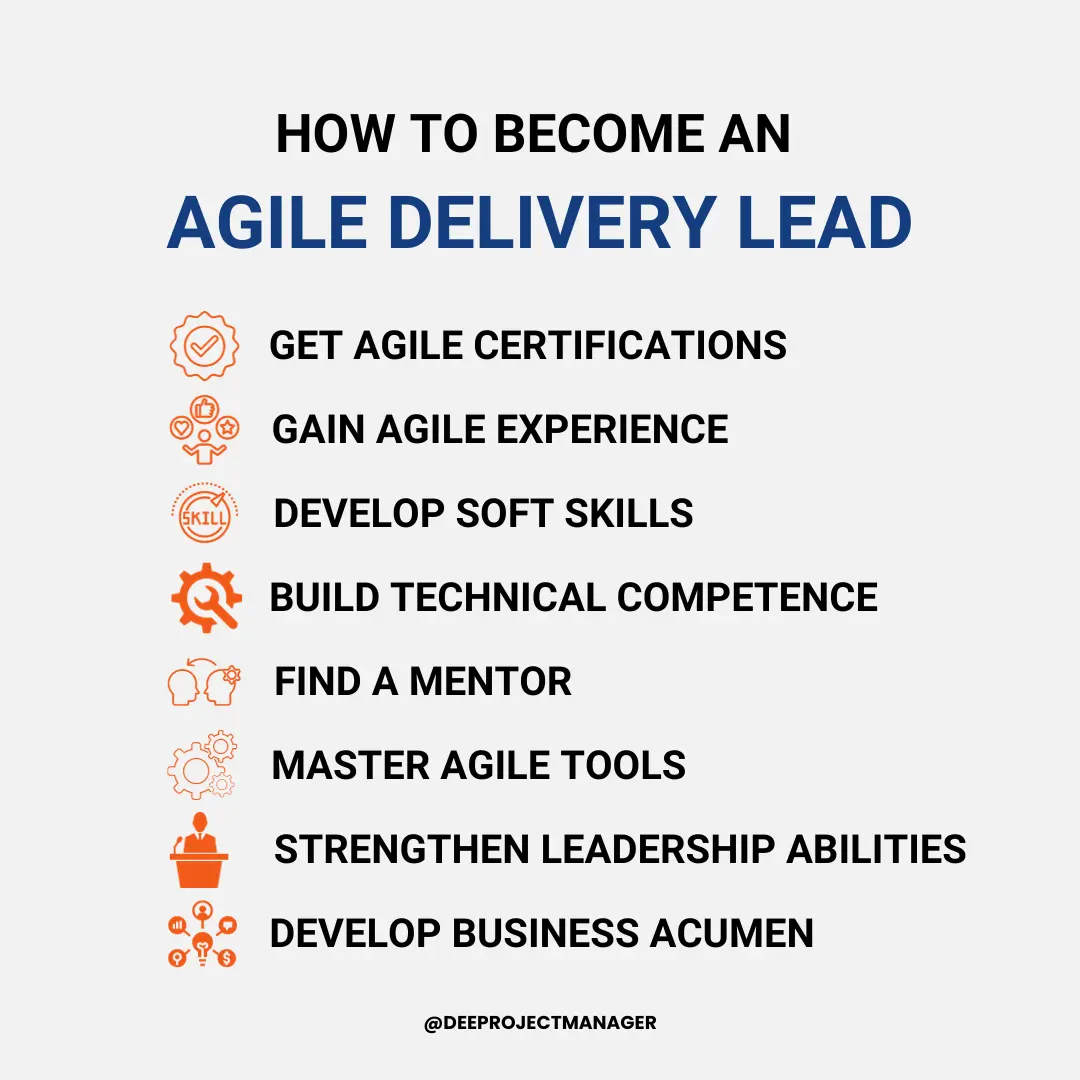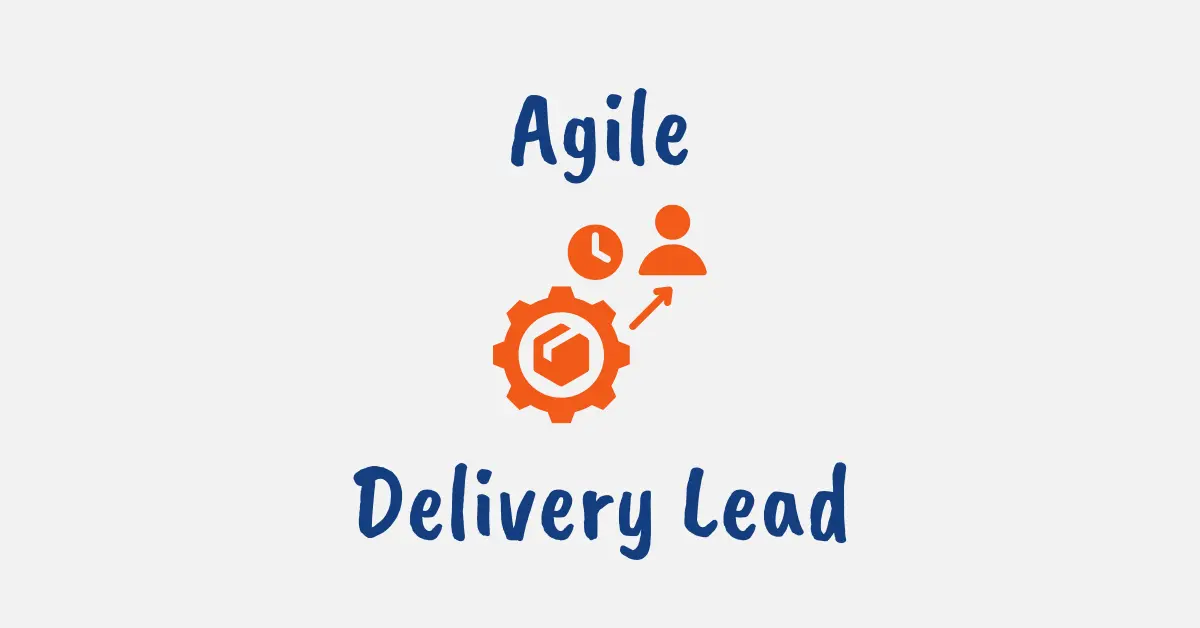As Agile methodologies like Scrum and Kanban gain popularity and evolve, organizations like Capital One are adopting new roles like the Agile Delivery Lead to help drive business results.
Agile Delivery Leads take on critical responsibilities to drive business results using Agile frameworks. However, it differs from similar roles like the Scrum Master and Project Manager.
In this post, we will explore key aspects of the Agile Delivery Lead role, how it compares to other roles, and tips on transitioning into this role.
Whether you’re considering this career path or want to better collaborate with your Delivery Leads, you’ll gain a solid understanding of this role and its place in advancing organizational agility.
What is an Agile Delivery Lead?
An Agile Delivery Lead is a leadership role that has emerged with the adoption of Agile approaches like Scrum, Kanban, SAFe, and hybrid methodologies.
The Agile Delivery Lead is responsible for coaching multiple Agile teams and overseeing the end-to-end delivery of products or services using Agile methods.
An Agile Delivery Lead facilitates Agile events like Sprints and standups across teams to drive alignment.
They also work closely with other roles like Scrum Masters, Product Owners, and engineering leads with the goal of enabling continuous delivery of valuable increments that delight customers.
Unlike a Scrum Master who focuses on one team, an Agile Delivery Lead takes a broader view and is accountable for the results of multiple teams or the overall product.
This role is ideal for experienced Agile practitioners ready to drive greater alignment and results at scale, and lead initiatives to improve technical practices, quality, velocity, and business value.

Agile Delivery Lead Responsibilities
The Agile Delivery Lead is accountable for guiding multiple Agile teams, facilitating coordination, and improving alignment across teams and with the business.
Their diverse responsibilities focus on enabling the continuous delivery of value through Agile methods and include:
Coaching Agile Teams
A core responsibility is coaching teams on Agile practices, troubleshooting issues, and mentoring team members. An Agile Delivery Lead serves as an expert Agile coach across several teams.
Enabling Alignment
The Agile Delivery Lead facilitates alignment on priorities and progress by coordinating key events like Sprint Planning, standups, retrospectives, and reviews across teams, as well as promoting collaboration and transparency.
Removing Impediments
Agile Delivery Leads are empowered to remove impediments. When bottlenecks or roadblocks surface, they step in to resolve escalated issues and keep teams productive.
Overseeing End-to-End Flow
By tracking dependencies and work in progress, an Agile Delivery Lead can identify and address bottlenecks in end-to-end flow.
Improving Technical Practices
An Agile Delivery Lead drives technical excellence by assessing solutions and practices to guide engineering teams on quality, architecture, automation, and DevOps.
Managing Risks and Tradeoffs
The Agile Delivery Lead makes tough decisions on priority conflicts and tradeoffs to deliver maximum business value, and mitigate risks that can impede Agile teams.

How to Become an Agile Delivery Lead
Transitioning into an Agile Delivery Lead role takes dedication and persistence. You’ll need to build up technical expertise, leadership abilities, and hands-on agile experience.
Here are some top tips to acquire the skills and experience needed for this role:
Get Agile Certifications
While they are not a guarantee of getting roles, certifications demonstrate commitment.
Earning credentials like PMI-ACP, PSM, CSM, or CSPO validates your knowledge of Agile frameworks.
Gain Agile Experience
The Agile Delivery Lead role requires adequate experience in Agile practices, leading teams, and technical knowledge.
You can gain this by serving as a Scrum Master or Product Owner first to learn the Agile rituals and team dynamics before leading multiple teams.
Develop Soft Skills
An Agile Delivery Lead guides without authority so strong facilitation, coaching, and leadership skills are essential. You can take courses to level up these competencies.
Build Technical Competence
From architecture to automation, you need solid technical know-how to earn credibility with development teams and improve engineering practices.
Find a Mentor
Seek mentorship opportunities as veteran Agile Delivery Leads and managers can share invaluable lessons and perspectives.
Master Agile Tools
Fluency with tools like Jira helps you manage complexity and enable transparency across teams.
Strengthen Leadership Abilities
The influence, collaboration, and strategic thinking skills of an Agile Delivery Lead are just as crucial as hard skills.
Develop Business Acumen
Understanding how technology delivers business value will allow you to make better product decisions and tradeoff calls.

Agile Delivery Lead Job Description Qualifications
The Agile Delivery Lead role requires a unique blend of leadership abilities, technical competence, and Agile experience.
Here are some typical qualifications and skills sought in an Agile Delivery Lead job description:
- 5+ years experience working in Agile teams, with at least 2 years as a Scrum Master or Product Owner
- Excellent grasp of Agile values, principles, and practices including experience facilitating events like Sprint Planning, standups, retrospectives, and reviews
- Coaching and mentorship skills to guide Agile teams through transformation and optimization
- Ability to influence without authority and lead through servant leadership
- Technical expertise including architecture, infrastructure, CI/CD pipelines, test automation, and other modern engineering practices
- Passion for continuous improvement and ability to optimize delivery workflows
- Outstanding communication, collaboration, and relationship-building skills
- Strategic thinking and problem-solving skills
- Experience guiding teams through conflict resolution and change
- Knowledge of various agile frameworks like Scrum, Kanban, SAFe, and Lean
- Certifications such as CSM, CSPO, or PMI-ACP
- Knowledge of Agile project management tools like Jira
- Leadership experience coordinating multiple teams with diverse skillsets
- High emotional intelligence and self-awareness

Agile Delivery Lead vs Scrum Master
The Agile Delivery Lead and Scrum Master roles are related but fulfill different purposes. While a Scrum Master facilitates one team, the Agile Delivery Lead is a leadership role guiding multiple teams.
Here is an overview of how they differ:
Responsibilities
Scrum Masters focus on coaching a single team in Agile ceremonies, values, and principles. Their scope is the optimized performance of one team.
In contrast, Agile Delivery Leads align priorities across multiple teams and oversee the end-to-end flow of value through systems with their scope on a set of teams or the overall product.
Skills
Scrum Masters require proficiency in Agile, facilitation, and coaching skills. Technical expertise is useful but not mandatory.
Conversely, Agile Delivery Leads need those same skills but also leadership, strategic thinking, influence, and technical knowledge to guide multiple teams.
Experience
The Scrum Master role is often an entry point for Agile practitioners with 2-3 years of experience sufficient in most cases.
On the other hand, Agile Delivery Leads typically have at least 5+ years of Agile experience and leadership skills developed from serving as Scrum Masters.
Focus
Scrum Masters focus on maximizing team effectiveness, health, and productivity with the team as their lens.
In contrast, Agile Delivery Leads optimize the flow of value across teams with the product or solution as their central lens.
Authority
Scrum Masters have authority on processes. However, the teams are self-organizing.
Agile Delivery Leads on the other hand have authority over teams within guardrails and are accountable for aligning teams to business goals.

Agile Delivery Lead vs Project Manager
The Agile Delivery Lead and traditional Project Manager roles differ significantly even though they both lead teams.
Here’s an overview of the key differences:
Process Control
Project Managers follow structured waterfall processes with strict control over plans, tasks, and schedules. They manage workstreams in a prescriptive fashion and limit flexibility.
On the other hand, Agile Delivery Leads embrace Agile values like collaboration, transparency, and adaptability. They facilitate the Agile process rather than controlling it, giving teams more autonomy.
Planning Approaches
Project Managers create detailed long-term plans with all requirements defined upfront. Changes require following defined change control procedures.
Agile Delivery Leads favor just-in-time planning in short Sprints, adapting to changing priorities, and embracing change as part of Agile planning.
Team Leadership
Project Managers direct team tasks, optimize individual efficiency, and ensure work aligns with the plan. Teams have less autonomy to self-organize.
Agile Delivery Leads coach self-organizing teams to deliver value collaboratively. They optimize end-to-end flow rather than individual output.
Leadership Style
Project Managers use authority to ensure compliance with the schedule and plan. Teams are not empowered to make decisions.
Agile Delivery Leads guide with influence and servant leadership. Teams are given a level of autonomy within guardrails to determine how to meet goals best.
Reporting
Project Managers report on performance versus plan and track velocity metrics. They focus on adherence and utilization.
Agile Delivery Leads measure business value, quality, flow, and team health. They care about outcomes over output.
Agile Delivery Lead Salary
Agile Delivery Lead salaries vary based on location, industry, company size, and years of relevant experience.
Leads with additional technical skills in development, DevOps, or cloud architecture also command higher compensation than those without hands-on skills.
According to Salary.com, the average Agile Delivery Lead salary is $145,709 per year in the United States, with higher earning potential on the coasts and at large tech companies.
Final Thoughts
The Agile Delivery Lead plays a crucial role in scaling Agile methods across multiple teams and guiding organizations to achieve the benefits of business agility.
This emerging role requires a blend of leadership abilities, technical expertise, and hands-on Agile experience.
As more companies adopt Agile, there is a growing demand for diverse roles including Agile Delivery Leads.
With the right qualifications and skills, this role offers an exciting career path for experienced Agile practitioners ready to advance and make an enterprise impact.





